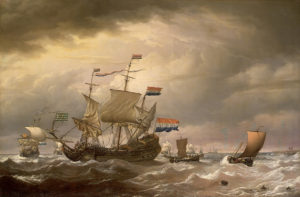
Pirates and Privateers on Long Island Sound
Part III
See part 1 here.
See part 2 here.
See part 4 here.
See part 5 here.
By Dan Shine
The Connecticut Coast has known a long history of piracy and privateering, and those errant souls who lived that way of life. Pirates were known variously as buccaneers, scalawags, freebooters, swashbucklers and corsairs. Traveling under sail and armed with flintlock pistol and cutlass, they would board merchant ships and seize their cargo by threat or by force.
Privateers were essentially pirating types, whose activities had been legalized by their governments as a political and economic expediency. It is a fact that privateers played a critical role in the defeat of the British during the American Revolution, by interrupting the flow of supplies and munitions to the Redcoats.
But what brought all of this piracy about, when did it begin and why did it end? Well, it’s like this…
The era of piracy in the Caribbean began in the 1500s and ended in the 1830s after the navies of the nations of Western Europe and North America began combatting pirates in earnest. The period during which pirates were most successful was from the 1660s to the 1730s.
Now, what does the Caribbean have to do with Connecticut? One factor was something called Triangular Trade, which used the powerful influence of prevailing winds and currents to propel ships under sail. Trade brought commodities from one region where they were not needed, to another where they were.
And how did it all work? Slaves were brought from Africa to the Caribbean and exchanged for molasses which went from there to New England and was distilled into rum. This rum and other goods were then shipped to Africa, and the cycle repeated itself—the entire cycle took about twelve weeks.
The barter system was common to the Triangular Trade, but not used exclusively: quantities of Spanish, French and Dutch coins were often to be found on merchant ships. The lure of easy money and high adventure were of great interest to the pirates.
In addition, there were ships bringing treasures of gold and jewels back from the Spanish Main to their home ports in Europe; naturally, pirates were well aware of this. Furthermore, pirates were known to leave their ships under guard and go ashore on raiding parties and attack settlements when they believed that the reward warranted the risk. At times, they returned through the jungles, laden with gold and jewels that they had taken by force of arms.
What might surprise us today is that these outlaws were not feared along the Connecticut coast: rather, they were welcomed with great support. For they were seen as traders of black-market products, necessary to the local economy, which was under the stranglehold of trade restrictions that the Colonists considered unfair. Every famous pirate travelled up and down the Eastern Seaboard, and most of them eventually made their way into Long Island Sound. As the story goes, after dark, they would sneak into the cove at the mouth of Oyster River, there to deliver their load of contraband to waiting hands, and be on their way.
To Be Continued-